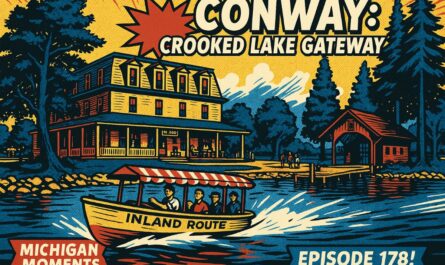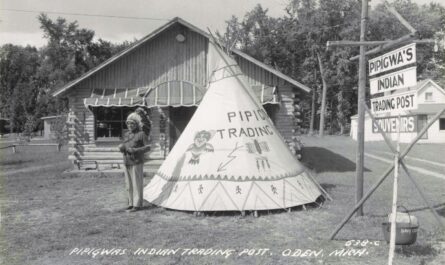Midland Michigan history is a story woven with industry and resilience. Originally a fur-trading post on the Chippewa River in the 1820s, Midland would come to be defined by its pioneering enterprises and the dramatic setbacks that followed. In 1897, chemist Herbert H. Dow chose Midland as the site for The Dow Chemical Company’s first plant. That single founding set the town on a path of rapid industrial growth. Yet even as factories rose, Midland’s story became marked by epic disasters: floods that swamped its streets and fires that razed its downtown. Through each trial, the city’s people rebuilt – brick by brick – renewing Midland’s spirit for the decades to follow.
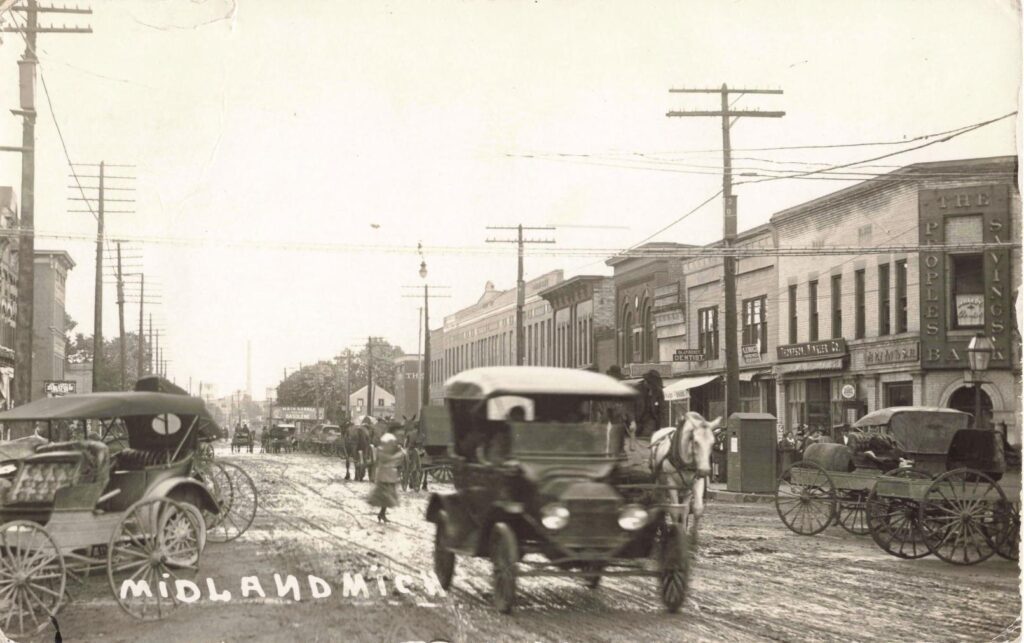
Midland grew up as a lumber and farming community on the Tittabawassee River. Midland Michigan history, really took shape after the railroad arrived in 1874. The city grew, and by 1887, it was officially incorporated in the 1890s. These events helped Midland grow, but the town also faced disasters. The History of Midland, Michigan includes many trials, from great floods to downtown fires.
Video – Midland Michigan history – Untold Stories of Disaster and Renewal
Midland Michigan History – Floods, Fires and Rebuilding

In January 1907, heavy rain and melting snow caused a historic flood on the Tittabawassee River. Water and ice tore over the riverbanks and into town. One newspaper said it was “the greatest flood ever known in the history of Midland”. The flood destroyed a covered bridge on Main Street and filled homes with ice-cold water. Many families were forced to stand on tables to stay above water. When the floodwaters finally went down, debris and damaged furniture blocked the streets. It took years for residents to clean up and rebuild after that record flood.

Floods continued to pose a danger throughout the 20th century. For example, in September 1986, heavy rains hit Midland and the nearby Saginaw Valley. Rivers crested suddenly and overflowed their banks. Roadways and schools had to close. Damage reached into the millions of dollars, though by luck, no one died in the flood. The 1907 and 1986 floods demonstrate how rapidly Midland can be overwhelmed by nature. Over time, officials built stronger levees and added flood warning systems to protect the city.
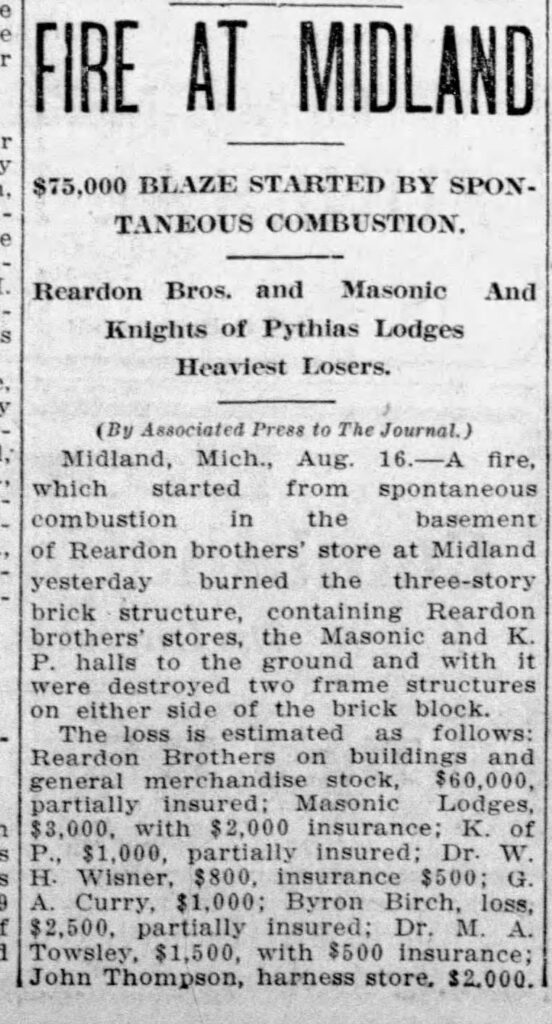
In August 1910, a sudden fire swept through Midland’s main street. The blaze burned the Reardon Block, a brick building that housed two Masonic lodges and other businesses. The fire caused approximately $75,000 in damage (a substantial loss at the time) and left community groups without a meeting hall. A newspaper story called it “the most disastrous and damaging loss by fire that the City of Midland has [ever seen]”. Luckily, the firefighters managed to keep the fire from spreading to other blocks. The city helped the Masons rebuild a new lodge hall soon after.
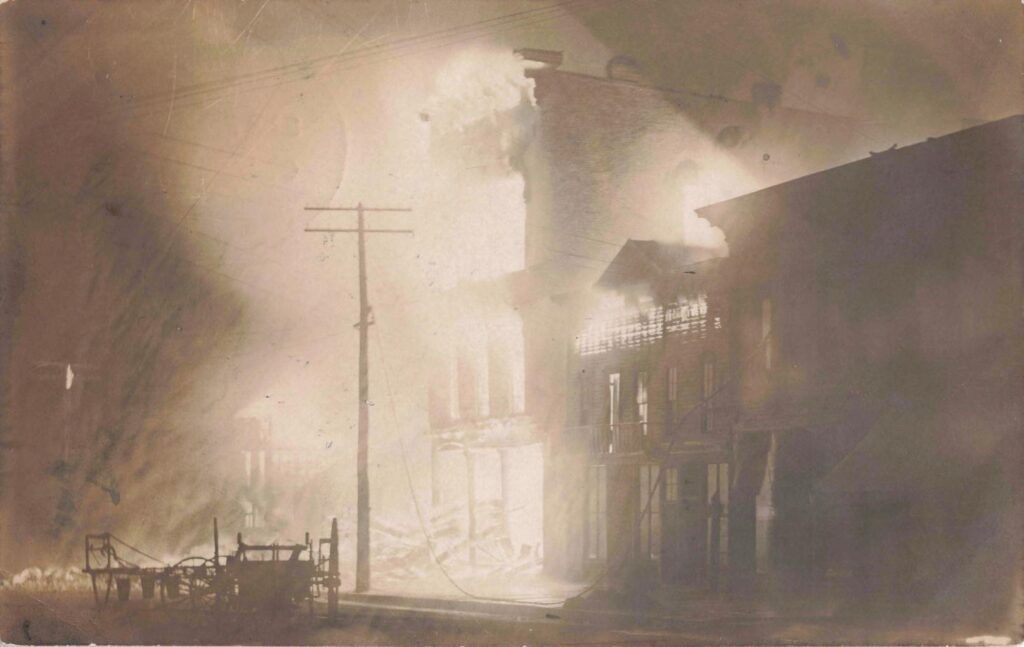
In another tragedy, a mill explosion shook Midland in 1892. A boiler at the local Salt and Lumber Company burst, sending bricks and iron flying into the air. The blast was heard up to five miles away. Three workers were killed and dozens more were injured when the boiler exploded. It was a violent reminder of the dangers in a lumber town. The mill stopped for months as it was rebuilt. Even though only three men died, the explosion hurt the town’s primary industry. People remembered it as a dark day in Midland’s history.
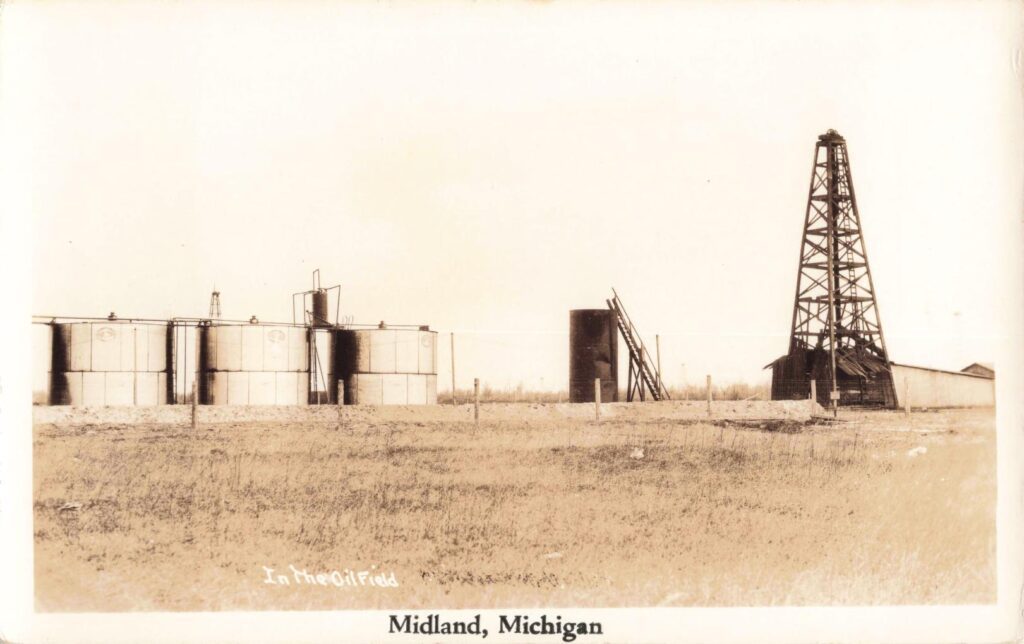
By the late 1800s, Midland had begun shifting its focus from wood and farming to chemicals and manufacturing. Local companies drilled for salt and oil in the river flats, and Herbert Dow used brine to make bleach. In 1897, Dow officially founded Dow Chemical in Midland. The Dow plant grew rapidly (as seen here) and transformed Midland into a leading chemical hub.
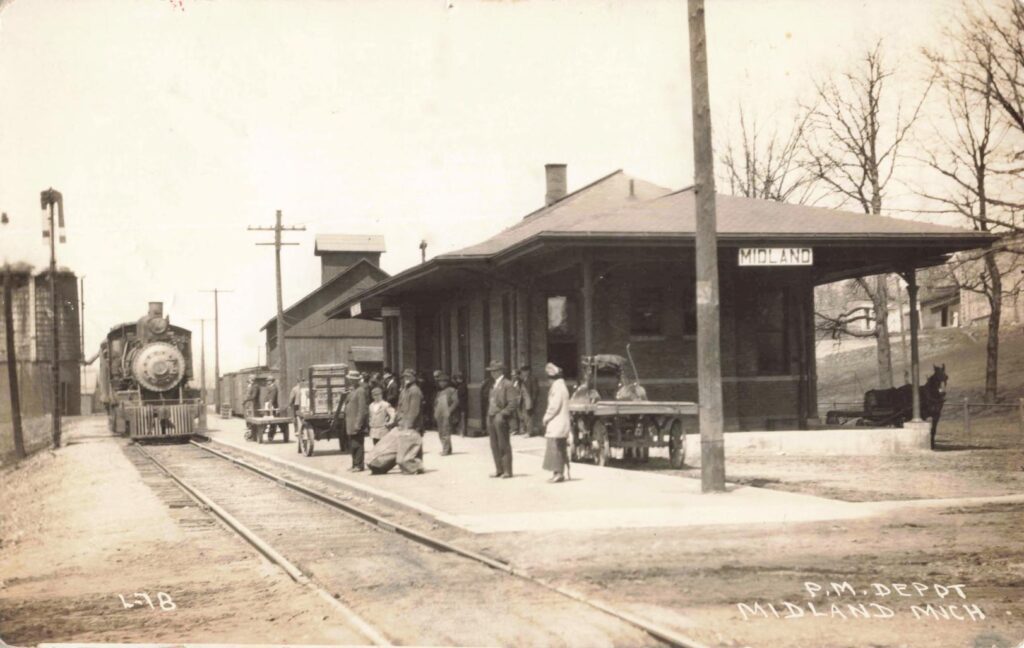
The railroad kept Midland connected. Trains ran through the downtown station on Main Street (pictured), linking Midland to Detroit, Chicago, and the rest of Michigan. This helped the city ship lumber, salt, and later chemicals to far markets. Over the decades, cars and trucks joined the trains. By mid-century, U.S. highways also ran past Midland, making road travel easy. These transportation links helped the Midland region recover and grow after each disaster.
Midland Michigan History – Industrial Rise and Dow’s Legacy

Dow Chemical began in a single chloride plant in 1897, but its legacy reverberated through Midland. “The Dow Chemical Company began as a one-product start-up founded by H.H. Dow” in Midland. From those modest beginnings (and a merger with Midland Chemical Co. in 1900), Dow expanded into a global chemicals giant. By World War I, the company was producing phenol and magnesium for munitions, seeding Midland’s prosperity. The plant pictured above – with its labyrinth of tanks and pipes – reflects how quickly Dow’s footprint grew.
As historian Doug Ashburn notes, “Dow’s founders persevered against those who nicknamed him ‘Crazy Dow’,” and within decades, Midland’s identity was inseparable from Dow’s presence. The industry drew workers, spurred new businesses, and even invested in civic projects (like schools and libraries) that would shape the town. By the 1920s, Midland’s skyline was dominated by Dow’s plants, solidifying its nickname as a “Chemics” town for generations.
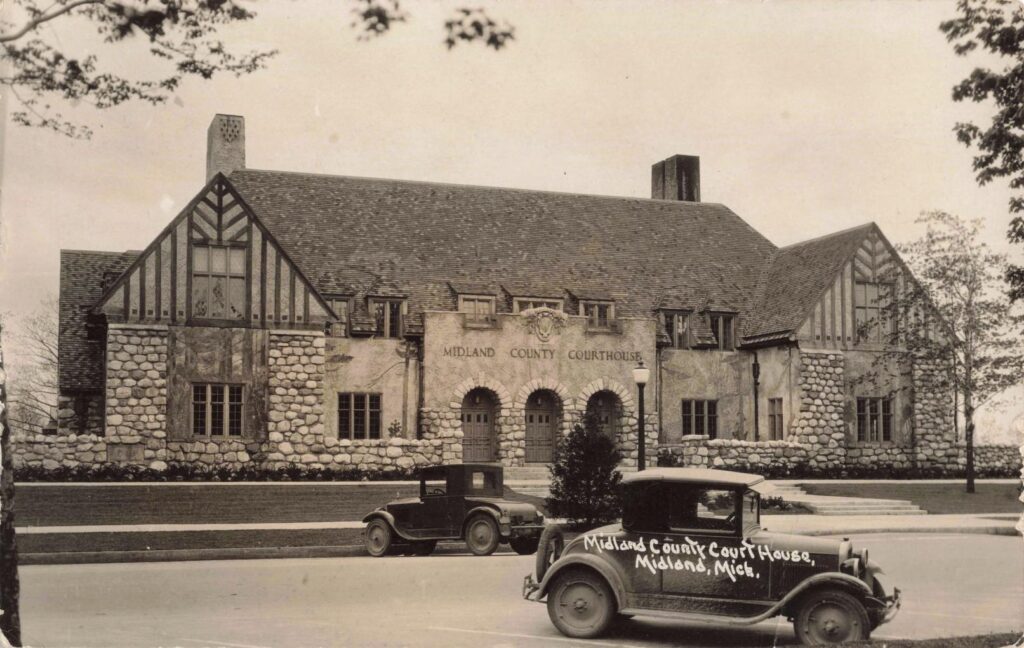
By the early 20th century, Dow Chemical was Midland’s largest employer. It operated big factory buildings like this, producing bleach, magnesium, and other chemicals. Many Midland families had members who worked at Dow. The company also helped the town – for example, the Grace A. Dow Library (seen today) was founded by Dow’s wife. Thanks to the industry, Midland could rebuild after floods and fires.
History of Midland Michigan: The Oil Boom of the 1920s
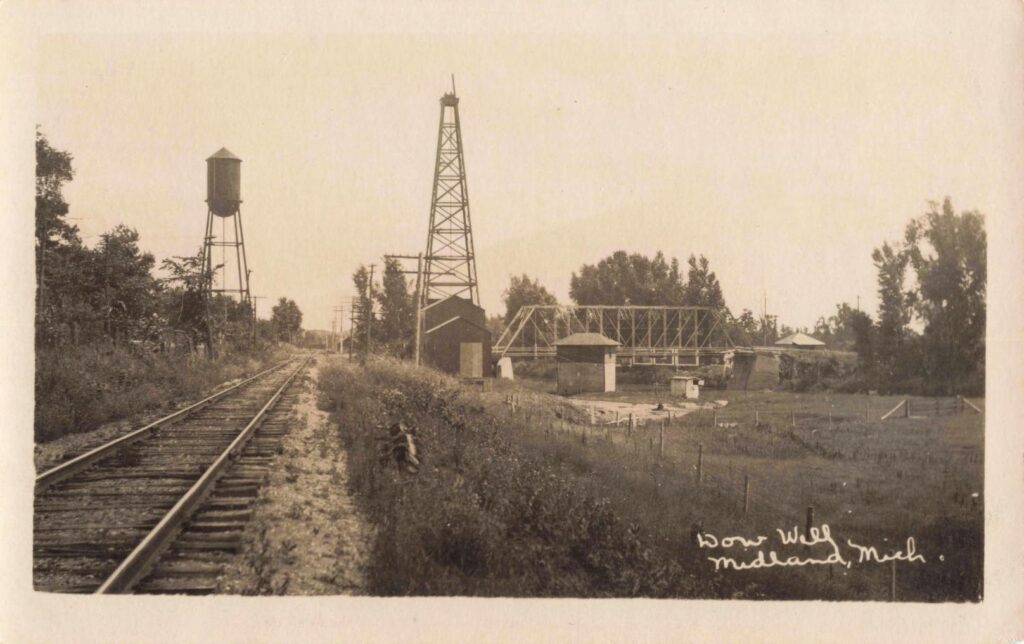
In the 1920s, Midland’s backcountry became the center of Michigan’s oil boom. Local geologists and investors found clues to oil while drilling brine wells for chlorine at Dow’s labs. One Midlander, Fred Sias, tested samples from a Dow brine well and staked 10,000 acres in Greendale Township. These leases paid off spectacularly. In early 1928, the Pure Oil Company drilled the Pure Root No.1 well on the Root farm. Newspapers trumpeted it as the “best oil strike in the state” – the drill bit had pierced 50–60 feet of rich oil sands at 3,554 feet deep. That well alone would yield some 29 million barrels.
Midland County soon saw dozens of new wells and supporting businesses. A company-built town, nicknamed “Oil City,” arose to house field workers, complete with pipelines running northeast to the Mt. Pleasant railhead. By 1933, another Midland field (Porter Township) produced gushers over 3,000 barrels per day. In just a decade, Midland had joined the ranks of America’s oil-producing regions – another layer of prosperity to its history.
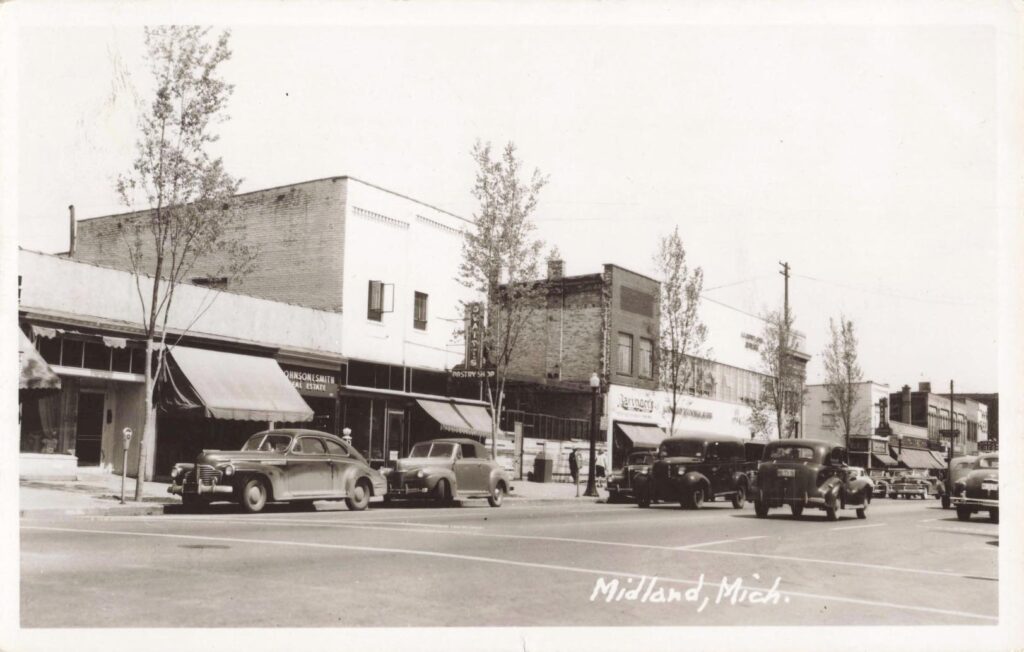
In the mid-1900s, Midland looked like a modern small city. The dusty streets of old were replaced by paved roads and new brick buildings (as shown). Old burned-out blocks were gone, replaced by updated shops and offices. The city built new schools, parks, and civic buildings. Midland even began to call itself the “City of Science and Culture” for its schools, art center, and museums.
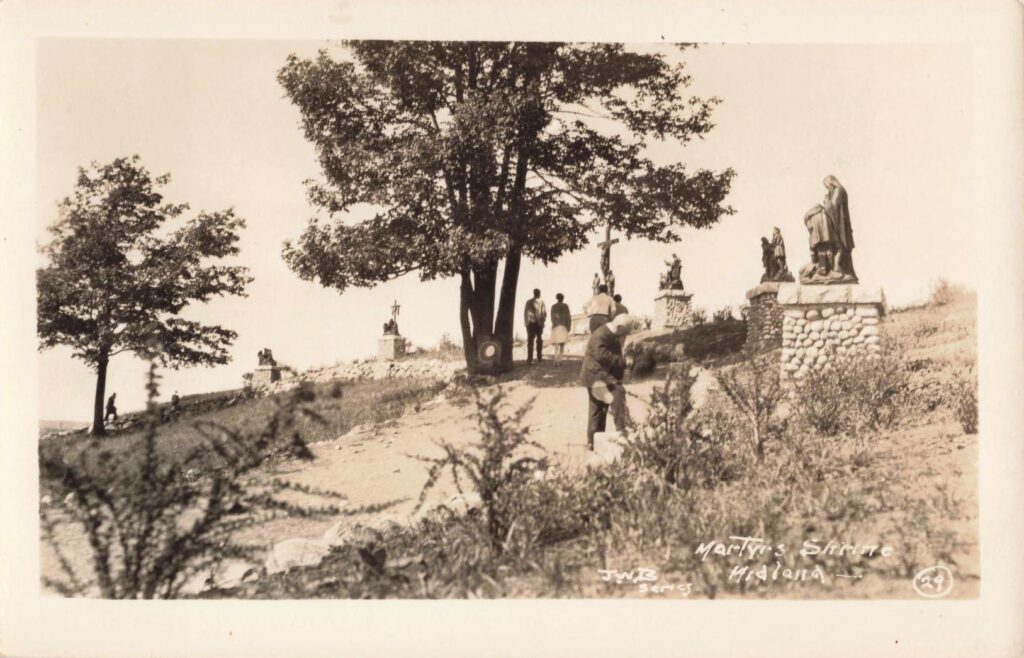
Midland’s recovery also included honoring its past. For example, the Field of the Woods Martyrs Shrine (seen above) was built in the late 20th century. It memorializes three Jesuit priests who were killed in 1670 in Michigan. This shrine and other local museums (like the Midland Center for the Arts) keep Midland’s history alive. The city today strikes a balance between growth and preserving its heritage.
Midland Michigan History – Community Renewal and Preservation
Today, Midland Michigan history shows a pattern of facing hard times and coming back stronger. Early disasters taught people to build better. Now, Midland has stronger dams and better fire safety than a century ago. The city government and Dow Chemical work together to protect Midland. Schools teach students about past floods and fires, ensuring that these lessons are not forgotten. Ultimately, the history of Midland, Michigan, is a tale of a river town that continually rebuilt after storms and fires, ultimately evolving into a thriving community.
| Year | Event | Outcome |
|---|---|---|
| 1850 | Midland County organized | Local government founded |
| 1874 | Railroad reached Midland | Better transport, business growth |
| 1887 | City of Midland incorporated | Official city government formed |
| 1892 | Mill explosion at Salt & Lumber Co. | 3 killed, mill rebuilt (lumber era declined) |
| 1907 | “Great Flood” on Tittabawassee River | Bridges washed out, town flooded |
| 1910 | Downtown Reardon Block fire | Masonic temple & shops burned |
| 1913 | Great Flood (rivers flooded) | Tracks and streets submerged (image above) |
| 1986 | Michigan flood | Millions in damage, no deaths |
| 2020 | Edenville/Sanford dam failures | Major flooding; thousands evacuated |
How did the Dow Chemical Company start in Midland?
The Dow Chemical Company was founded in Midland in 1897 by chemist Herbert H. Dow. Dow initially needed a plant to produce bleach (using by-products from its brine extraction work). Over the next few years, he incorporated Midland Chemical Company into Dow (in 1900) and expanded into new products (phenol, magnesium, etc.). Dow’s growth provided hundreds of local jobs and made Midland a hub for the chemical industry in the 20th century.
What were the major floods in Midland’s history?
Midland suffered several significant floods. The most infamous early flood occurred in May 1912 when record rains sent the Tittabawassee River over its banks, submerging much of downtown (as documented by postcards of the time). Earlier in 1907, the county also saw major flooding, and as recently as 2020, Midland endured a catastrophic dam failure flood. Each disaster inundated homes and businesses, spurring stronger river levees and emergency planning in subsequent years.
What caused the devastating downtown fire in 1910, and what was its impact?
The Aug. 14, 1910, blaze started in the basement of the Reardon Brothers Mercantile store (likely from spontaneous combustion of stored goods). Fueled by stored gunpowder and gasoline, the fire consumed the three-story Reardon Block and two adjacent buildings. Contemporary accounts call it “the most disastrous…loss by fire since [1876]”. Losses were estimated at $45,000 (with only $30,000 insured). Remarkably, the owners had rebuilding plans drawn up within 48 hours, and Midland’s downtown rose again with new structures in its place.
Works Cited In Midland Michigan History
Aldridge, Chris. “Our tribute to Michigan’s 180th birthday — and Midland’s 130th.” Midland Daily News, 26 Jan. 2017.
Centre Lodge #273. “History.” Midland Masons. Midland Chapter of the Eastern Star.
Clark, Anna. “When the Dams Broke in Midland, Michigan.” Belt Magazine, 17 July 2020,
Florey, Virginia. “1907 flood called the greatest flood ever in Midland.” Midland Daily News, 2 June 2004, .
Skory, Gary F. “A Window into Midland’s Past: Three killed in 1892 explosion in Midland.” Midland Daily News, 10 Dec. 1992, .
The Dow Chemical Company. History of Dow: Timeline. Dow (corporate site).

